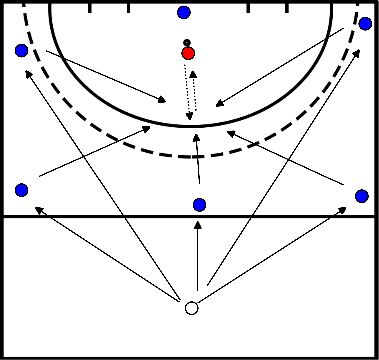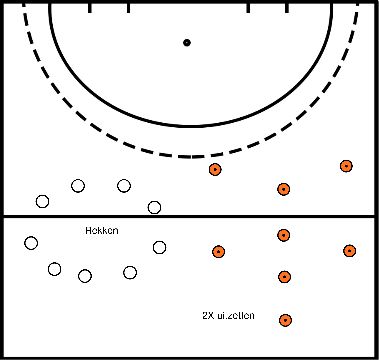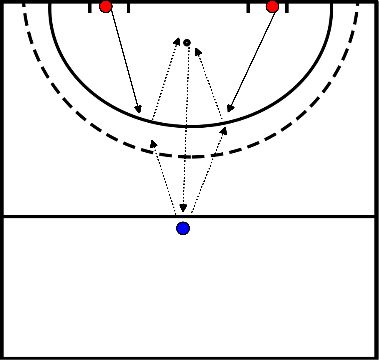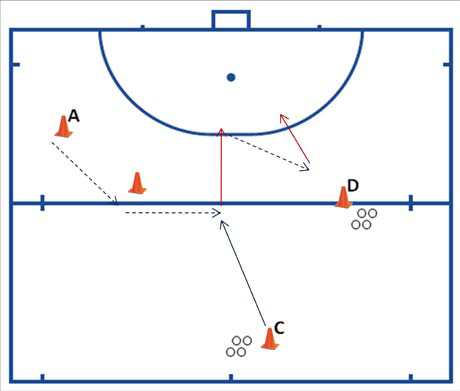Hockey drills
The exercises can be played in 2 variants the variant for really beginning hockey players (this exercise can be used for a clinic for example) and the variant intended for beginning hockey players who have already been in touch with hockey.
Variation 1:
- Player 1 plays the ball to player 2,
- Player 2 receives the ball and passes to player 3.
- Player 3 receives the ball and shoots at goal.
- Player 4 tries to stop the ball with the bottom of his foot or with his stick.
- Player 4 retrieves the ball and joins the back of the line at the starting pawn of player 1.
- For safety's sake don't shoot on target when player 4 picks up the ball.
- It is also possible to get the balls out of the goal later or use a break for that.
- This is for safety reasons.
Two teams with substitutes, substitutions are made when a goal is scored.
Each person defends a goal, on each field there are 5 goals, so there are also 5 people who defend these goals.
If a goal is scored in your goal, you have to sit on the sidelines and you are changed. A new player (substitute) from the side enters the field and will defend the goal.
If a goal is scored, it is 1 point. The team with the most points at the end of the game is the winner.
Variation:
First 1 ball, then several balls in the field.
The pass to the right goes diagonally forward and over the backhand side of the defender, the pass to the left you play wide and goes over the forehand side of the defender.
Therefore the pass to the right is preferred over the pass to the left.
- This is a basic exercise in preparation.
- Just like a tennis player who prepares for training with basic strokes, the players must prepare for the complex training and competition forms, with direct simple passes on top of each other.
- In this way, the trainer has the ability to see technical errors in each individual player and correct them as early as the basic exercise.
- The players pass the ball directly between two pylons and walk counter-clockwise to the other side.
- The size of the target and the distance between the players will be adjusted according to the age and level of the players.
- Blue player receives the ball from the white player each time. (white player distributed)
- Red player runs from stroke point to head circle and receives ball from blue player.
- Red player shoots on goal.
- After each shot he walks back to stroke point and then receives the next ball from head circle.

- We run as a team from one sideline to the other which is on the other side.
- When we get there we jog back as a team and then jog up and down again.
- We divide the group into two equal groups.
- So that we can perform the warm-up a bit faster
- We jog to the first pilon there you run backwards back to your starting position.
- Then you jog to the second pilon, when you get there you go back to the first pilon.
- Until you reach the end of the jog you go back to the first pilon twice.
- Knee lift to the pilon
- heels to buttocks to the next pilon
- Then lift knee again
- The last one is again heel to buttocks 2x
- You start waving your arm forward to the end of the line, back with your right arm.
- Now you're going to swing two arms forward to the end of the line, back with your arms backwards.
- We jog to the second pilon from there and accelerate with a sideways pass to the pilon on your left or right.
- Once there you accelerate again with a forward motion to the pilon in front of you. 2x
- The last one is that we will sprint, you jump 3 times in the light and then perform a constructive sprint to the center of the field or the indicated pilon. 2x
- After this we take a short time to stretch the muscles.

- There are 2 passers on the PC points on the back line to the right and left of the goal.
- The player starts behind the 25 yard line, receives the ball from the left, gets the ball to the semi-circle and then has to score.
- This player then sprints past the penalty mark, then sprints back behind the 25 yard line, and then has to run back towards the goal to receive the pass from the other attacker (right) and do the same (scoring, sprint past the strokepunt/puntball point and back to the 25 yard line)

- Put out the columns as shown in the figure
- Spread the balls over pylon C and D.
- In this exercise you place a player at pylon C and D.
- The rest of the team will line up at pylon A.
- From A onwards, the player walks around the pylon
- From the post, the player makes a sideways movement facing the ball (facing C).
- Player C plays the ball in the forehand of A
- A takes the ball and turns right open
- A runs in the direction of the circle and finishes at goal.
- From here he runs to D and receives another ball.
- The player turns open to the left and finishes on goal again.


- The tagger should try to tap as many children as possible.
- If you are in danger of getting tapped you can call a television show and then the tagger is not allowed to tap you.
- You have to stand with your legs wide.
- The rest can be relieved by crawling between your legs.
- When you are tapped, you stand by the trainer.

- One tagger has a stick in one hand and taps with his other hand.
- The tagged player will then hold the stick with it and also tap with it.
- The tagger must not let go of the stick.
- If there is a large group, assign two or more taggers.

- 1 player has a stick and a tagger is assigned;
- only the player who has the stick may be tapped, so the stick is always passed on quickly (vertically for safety reasons and do not throw it!).
- If the tagger doesn't have a chance, add more than one stick to the game.

- Pass the ball to a fellow player under/over the pylons with stick.
- Passes: push, slide and flats.
- Stick at different heights
- increase distance between each other
- pylons closer together (gate smaller)
- Perform the exercise with groups of three









